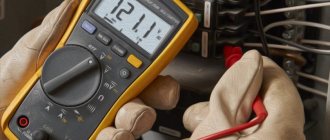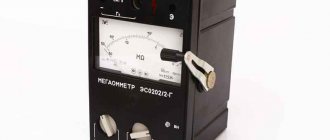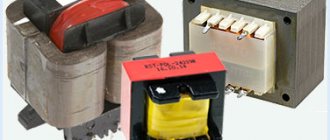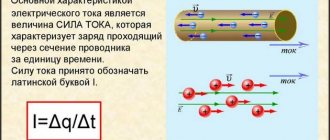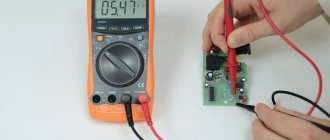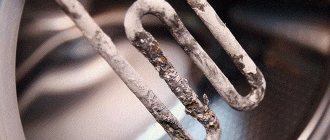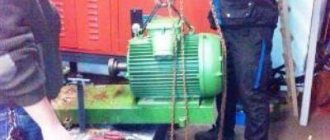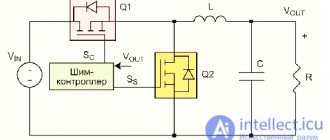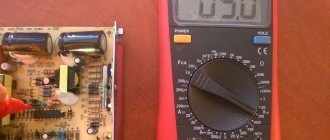Physical meaning of resistance
Electric current is the movement of charged particles in a certain direction, which is initiated by a difference in voltage at the ends of a conductor. Current-conducting materials have resistance, which can be visualized as frictional force. The more obstacles the electrons encounter on their way, the faster they lose energy.
The resistance value depends on the properties of the conductor material, its length and cross-sectional area. Copper has the best conductivity among available metals, which is why modern power lines and electrical wiring are made of copper conductors. The energy losses of such lines are much less than those of aluminum or steel.
Resistance is influenced by environmental conditions. Some materials, when reaching a critical temperature of about -200°C, exhibit superconductivity, that is, zero resistance. This allows them to be used for the manufacture of complex equipment and powerful turbogenerators.
In elements such as heating elements or heating cables, on the contrary, the resistance is very high. By transferring some of the energy from charged particles to the conductor material, the device heats up and transfers heat to the surrounding space.
Not only conductors have resistance, but also current sources, measuring instruments, capacitors, coils, and contacts in connections. There are 3 types of resistance:
- active at direct and alternating current;
- inductive;
- capacitive
In size it can be small, medium and large. The lower the value, the more strongly the resistance of the device itself and its contacts affects the measurement result.
What is wire insulation resistance
Insulation resistance is one of the most important parameters of any cables and conductors. This is based on the fact that all wires are subject to external influences during their operation. In addition to external influence, there are also internal ones: the influence of the cores of one wire on each other, interaction through electromagnetic fields. All this, one way or another, leads to leaks.
Industrial megger for measuring large resistance values
That is why any electrical and non-electrical wires are created with insulation that protects the conductor from external influences. Popular insulating materials include rubber, polyvinyl chloride, oil, wood and paper. These materials are used based on the purpose of the cable. For example, wires buried underground are insulated with relatively thick dielectric tape, while telecommunications cables may be enclosed in a simple aluminum foil wrapper.
Old Soviet analog bench ohmmeter
Important! Insulation is the protection of cores from exposure to otherworldly factors, protection of cores from each other, from short circuits and from various leaks. Insulation resistance is the amount of resistance between the conductors of a wire or between one of the conductors and the insulating layer.
Any material ages and deteriorates over time, which leads to deterioration of its characteristics and a decrease in insulation resistance to direct or alternating current. The insulation resistance characteristic is indicated on the cable and is standardized in its GOST. It is determined in laboratory conditions at a temperature of 20 degrees.
Carrying out resistance measurements with a professional megohmmeter
Low-frequency communication cables have a minimum insulation resistance of 5 Gigaohms per kilometer, and coaxial cables, in turn, have a minimum insulation resistance of 10 Gigaohms per kilometer. Measurement and testing of resistance is carried out on a regular basis with a megohmmeter: at mobile communication installations - once every 6 months, at high-risk facilities - once every 12 months, at other facilities - once every three years.
You might be interested in checking amperes with a multimeter
Resistor to increase the resistance of the electrical network
Ohm's law
The pattern between three characteristics - current I, voltage U and resistance R - was established by the German physicist Georg Ohm in 1826. He found out that they are connected by a fairly simple relationship:
I=U/R
Based on the formula and knowing any 2 quantities, it is very easy to find the missing third:
U=I*R
R=U/I
In turn, the resistance depends on the properties of the material and the size of the conductor:
R=ρ*l/s, where ρ is the resistivity per 1 m (tabular value), l is the length, s is the area of the conductor.
Consumers in the circuit (resistors) can be connected in series, that is, without branching. To find the total resistance, all values are added together:
Rtot. = R1 + R2+…
The current strength will be the same in all sections, but the voltage will be different:
With a parallel connection, the dependency is more complex:
1/Rtotal=1/R1+1/R2+…
In this case, the voltage is constant, but the current strength in each section is different.
Often there are mixed circuits where serial and parallel connections of resistors are combined. You can check the parameters of a circuit of any configuration using measuring instruments.
In what units is resistance measured?
Electrical resistance is the resistance offered by a conductor to an electric current passing through it. The main unit of measurement in the SI system will be ohm; in the GHS system there is no special indicator. Resistance (often symbolized by the letter R) is considered, within certain limits, to be constant for a particular conductor.
- R - resistance;
- U is the difference in electrical potential at the ends of the conductor in volts;
- I - the current that flows between the ends of the conductor under the influence of a potential difference, measured in amperes.
Resistance measurement
Resistance multimeter
To determine various electrical characteristics, it is very convenient to use a universal digital tester. It measures not only resistance, but also voltage, current, capacitance, etc. The range of functions and the accuracy of the data obtained depend on where the multimeter is intended to be used - at home or professional work. Some models can connect to a personal computer and exchange information with it.
On the body of the device there is a scale with a mode switch, connectors for connecting probes and a display for reading the results. The kit includes 2 probes - red and black.
Additionally, a thermocouple can be switched on. Power is supplied from AA batteries or the “crown” type. Testing with a multimeter helps to identify and eliminate problems in a section of the circuit - breaks, voltage drops, insulation breakdown.
Visual check of the resistor condition
Before checking the resistor with a multimeter, you should inspect it. In this case, you need to pay attention to the presence of the following signs:
- There is noticeable darkening on the body. If the darkening is slight, this indicates slight overheating, at which the part can remain operational.
- The appearance of a specific odor.
- The markings become faintly visible.
- Burnt tracks are visible on the board.
If there is obvious damage, the faulty part should be removed and a resistor with the same value installed in its place. If the resistance appears to be working outwardly, it is necessary to check for serviceability using a multimeter.
How to measure resistance with a multimeter: procedure
Tests are carried out without a network connection. The battery supplies a small voltage to the contacts, so no other current source is needed. Thanks to this, the measurement does not pose a threat to humans and is considered safe.
Setting the mode and selecting the range
To check the resistance, a sector marked with the letter Ω (omega) is highlighted on the multimeter scale. To set the required precision register, you need to determine the expected order of magnitude:
- up to 200 Ohm;
- up to 2000 Ohm (2K);
- up to 20K;
- up to 200K;
- up to 2000K (2M).
Some instruments can measure resistances up to 200 megaohms (200m). They are used to test high capacitance resistors. Poorly conductive dielectrics from which wire insulation is made are examined using megaohmmeters. Multimeters are not suitable for this purpose because they cannot generate large currents, and their range is limited to a maximum of 200 mOhm.
Connecting probes
To take measurements, you need to insert the probes into the connectors on the device body:
- black - into the COM socket;
- red - in VΩmA.
With this arrangement, the “minus” will be fed to the black conductor, the “plus” to the red. Conventional resistors have no polarity; they can be connected to conductors in any order.
Measurements
Despite the fact that you are not in danger of receiving an electric shock, it is advisable not to touch the contacts with your fingers. Otherwise, the multimeter will display data with an error. Because the human body's resistance ranges from 3 to 100 ohms, the error may be very large.
Before starting measurements, it is recommended to connect the ends of the probes and check the conductors themselves directly. This is especially important if resistors with small R are being studied, where tenths of an ohm can make a difference.
After determining the resistance of the probes, this figure must be remembered in order to be subtracted from all further results.
Measurements are taken when the tips come into contact with the element contacts. The data is read from the display and, if necessary, converted to Ohms, taking into account the prefixes to the number:
- k - kilo, 1000;
- m - mega, 1000,000.
If the range is set correctly, the value will be different from 0. For a more accurate measurement, you can turn the switch to a lower number.
If 0 is displayed on the screen, the limit is gradually reduced until a numerical result is obtained. When only the number 1 is visible on the device, this means that the resistance is infinite. Due to an open circuit, there is no current in the circuit.
Analog and digital multimeters
The operation of measuring instruments is based on Ohm's law. It defines the concept of resistance, represented as the ratio of the voltage in a conductor to the current flowing in the same conductor (R = U/I). Thus, a resistance of 1 Ohm corresponds to a current of 1 A with a voltage of 1 V. Therefore, if the voltage and current are known in advance, then calculating and measuring the resistance is not at all difficult. The simplest ohmmeter is essentially both a current source and an ammeter with a scale marked in Ohms.
Initially, instruments for measuring resistance could perform only one function. The measurement was carried out in the shortest possible time and gave accurate results. Subsequently, universal measuring devices appeared - multimeters, where the ohmmeter is only one of the components, included in the desired mode. You also need to be able to use analog devices correctly, from connecting to processing the received data.
The appearance of digital and analog devices is noticeably different. In the first case, the measurement results are displayed on the display in the form of specific digital indicators. In analog instruments, instead of a display, a graduated dial is used, where the needle stops near the desired value. Thus, digital multimeters immediately allow you to determine and provide ready-made data, while analog multimeters require additional processing of the results obtained.
Digital multimeters are equipped with a sensor that indicates the degree of discharge of the power source. If the current is insufficient, the device simply will not work. In such situations, analog devices do not signal in any way, but begin to provide incorrect information. As a rule, any multimeters with sufficient values of the limits of measured resistance can be used in everyday life. They allow you to perform any task, including measuring the resistance of a resistor.
Variable resistor resistance
If with a constant resistor everything is more or less clear - its resistance is indicated on the case in the form of symbols or colored stripes - then with a variable resistor it is a little more complicated. Such devices are used in devices where it is necessary to periodically change the resistance of the element, for example, when adjusting the sound volume.
Variable resistors have multiple outputs. To determine the connection between them, you need to install the end of the black probe on 1 leg, and touch the rest one by one with the red one. Where there is no conductivity, the multimeter will show 1. If there are numbers on the screen, then this pair of contacts is one of the resistances of the variable resistor.
Next, it is determined which bends are extreme and which are intermediate. The resistance of each pair is measured. The sum of the internal values must be equal to the resistance on the external contacts, that is, its nominal value.
To check, you can turn the variable resistor knob with the probes connected to the taps. If the resistance changes, it means that one terminal is outer, the second is internal movable.
How to measure correctly
To correctly measure the resistance parameters of a wire or cable you need:
- Turn on the multimeter and set it to the appropriate values;
- Connect one probe in any way to one contact of a wire or element, and the other to another free one;
- If one lights up on the display, then the maximum power is not enough and you need to set a higher limit;
- Compare the obtained values with the nominal markings.
Important! During the measurement process, you should adhere to simple but important safety measures: do not touch the exposed parts of the probes with your hands and be careful when measuring the parameters of some types of electrical appliances.
Correct and safe measurement is essential for accurate results
Thus, the electrical network can be determined by many parameters, one of which is resistance. The multimeter way to find out resistance is one of the most common and simplest. This does not require any special knowledge or skills. It is enough to have the subject of analysis and the apparatus to check and record the relevant data.
Ground resistance
To reduce the touch voltage to a safe value in the event of a short circuit, a ground electrode is used. This device has low resistance, allowing electricity to flow through conductive elements into the ground. This is where the name of this important component of the electrical safety system comes from.
Grounding resistance is standardized depending on the type of object and energy consumption. So in three-phase networks with a voltage of 380 V it should not exceed 4 Ohms, in single-phase networks with a voltage of 220 V - 8 Ohms.
The operation of the circuit is checked using special grounding parameters meters - M-416, MRU-105, Metrel and others. Unlike household multimeters, they are much more powerful, have long probes, and use batteries, power lines, or a built-in generator as a power source. The voltage in the circuit can reach 1000 V. Using such installations, it is possible to measure grounding resistance, soil resistivity, as well as step and contact voltage.
To carry out the work you will need 2 pins and a set of wires. First you need to remove oxides from the grounding contacts; for this, a rasp or file is useful.
The potential electrode is driven at a distance of 15 m from the building, the current electrode is 30 m, then connected by wires to the tester according to the diagram. When the probe touches the stripped grounding contact, the device passes current through the electrodes and determines the voltage and current strength. It independently carries out calculations and gives readings in Ohms.
Another way to find ground resistance is to measure it with a current clamp. In this case, there is no need to use additional wires and electrodes or partially disconnect the ground electrodes in case of a complex connection diagram. The wires are simply covered by the detachable cheeks of the device, inside of which magnetic circuits are located. The fit of the conductors and contacts of the meter should be as tight as possible to reduce errors. After taking readings at one point, you can immediately move to work in another place.
Device settings before measurements
So, friends, let's take a closer look at the device itself. In my case it is a DT9208A digital multimeter. The standard kit includes one pair of probes for force measurements and a thermocouple for measuring temperature, which I have never used before.
There is a rotary switch on the front panel. It is with this switch that the operating mode and measurement range are selected. The switch works like a “ratchet” and is fixed in each new position.
The entire circular panel is divided into sectors and has multi-colored markings (this is in my case). Sometimes sectors are outlined with separate lines, as if separating the required parameter.
The resistance measurement sector is located at the top and is divided into seven ranges: 200, 2k, 20k, 200k, 2M, 20M, 200M. The prefixes "k" and "M" stand for kilo (10 to the 3rd power) and mega (10 to the 6th power), respectively.
To operate, the switch must be set to the desired sector position. We are interested in resistance; therefore, before measuring resistance with a multimeter, we need to set the switch to the sector indicated by the “Ω” icon.
For ease of use with the device, the probes have different colors. It makes no difference where to insert which probe, but the generally accepted rule is that the black probe is inserted into the terminal marked “com” (short for common), and the red probe is inserted into the terminal marked “VΩCX+”.
Before performing any measurements, it is necessary to check the functionality of the device itself, since there may be a break in the measuring circuit (for example, poor contact of the probes). To do this, the ends of the probes are short-circuited with each other. If the device is working properly and there is no break in the circuit, then zero readings will appear on the display. Perhaps the readings will not be zero, but thousandths of an ohm. This is due to the resistance of the test leads and the transition resistance between the probes and their terminals.
When the probes are open, the display will show “1” (one) with a measurement range mark.
These simple steps prepare a multimeter for measuring resistance.
Some multimeters are equipped with a useful option called “diagnosis”. If you set the operating mode switch to the diode icon, a signal (buzzer) sounds when the probes are shorted. This allows you to check the health of circuits and direct junctions of semiconductors with a resistance of up to 50 Ohms by ear, without being distracted by the display.
Checking the grounding in the socket
Signs of a lack of grounding may be frequent failures of household appliances, light electric shocks from metal parts of electrical appliances (if there is a breakdown on the body), or two-wire wiring. You can determine the presence of grounding in the socket using a multimeter in voltage measurement mode:
- Install the switch in the ACV segment at 750 V.
- Connect the probes to the COM and VΩmA connectors.
- Turn on the device.
If there is no third input in the socket, it must be disassembled by first de-energizing it using an RCD. Take readings between phase and zero and between phase and ground. If the voltage at the contacts is 220±10% everywhere, then the grounding is working properly.
Checking diodes with a multimeter or tester
Semiconductor diodes are widely used in electrical circuits to convert alternating current to direct current, and usually when repairing products, after an external inspection of the printed circuit board, the diodes are first checked. Diodes are made from germanium, silicon and other semiconductor materials.
In appearance, diodes come in different shapes, transparent and colored, in a metal, glass or plastic case. But they always have two conclusions and immediately catch the eye. The circuits mainly use rectifier diodes, zener diodes and LEDs.
The symbol for diodes in the diagram is an arrow pointing to a straight line segment. A diode is designated by the Latin letters VD, with the exception of LEDs, which are designated by the letters HL. Depending on the purpose of the diodes, additional elements are added to the designation scheme, which is reflected in the drawing above. Since there is more than one diode in a circuit, for convenience, a serial number is added after the letters VD or HL.
It is much easier to check a diode if you understand how it works. And the diode works like a nipple. When you inflate a ball, rubber boat or car tire, air enters it, but the nipple does not allow it back.
A diode works exactly the same. Only it passes in one direction not air, but electric current. Therefore, to check the diode, you need a direct current source, which can be a multimeter or a pointer tester, since they have a battery installed.
Above is a block diagram of the operation of a multimeter or tester in resistance measurement mode. As you can see, a DC voltage of a certain polarity is supplied to the terminals. It is customary to apply the plus to the red terminal, and the minus to the black. When you touch the diode terminals in such a way that the positive output of the device is on the anode terminal of the diode, and the negative output is on the cathode of the diode, then current will flow through the diode. If the probes are swapped, the diode will not pass current.
A diode can usually have three states - good, broken or broken. During a breakdown, the diode turns into a piece of wire; it will pass current no matter the order in which the probes touch. If there is a break, on the contrary, the current will never flow. Rarely, but there is another condition when the transition resistance changes. Such a malfunction can be determined by the readings on the display.
Using the above instructions, you can check rectifier diodes, zener diodes, Schottky diodes and LEDs, both with leads and in SMD version. Let's look at how to test diodes in practice.
First of all, it is necessary, observing the color coding, to insert the probes into the multimeter. Usually a black wire is inserted into COM, and a red wire into V/R/f (this is the positive terminal of the battery). Next, you need to set the operating mode switch to the dialing position (if there is such a measurement function), as in the photo, or to the 2kOm position. Turn on the device, close the ends of the probes and make sure it is working.
We’ll start the practice by checking the ancient germanium diode D7, this specimen is already 53 years old. Germanium-based diodes are now practically not produced due to the high cost of germanium itself and the low maximum operating temperature, only 80-100°C. But these diodes have the smallest voltage drop and noise level. They are highly valued by tube amplifier builders. In direct connection, the voltage drop across a germanium diode is only 0.129 V. The dial tester will show approximately 130 Ohms. When the polarity is changed, the multimeter shows 1, the dial tester will show infinity, which means a very high resistance. This diode is OK.
The procedure for checking silicon diodes is no different from checking those made of germanium. The cathode terminal is usually marked on the diode body; it can be a circle, line or dot. In direct connection, the drop across the diode junction is about 0.5 V. For powerful diodes, the drop voltage is less, and is about 0.4 V. Zener diodes and Schottky diodes are checked in the same way. The voltage drop of Schottky diodes is about 0.2 V.
For high-power LEDs, more than 2 V drops at the direct junction and the device can show 1. But here the LED itself is an indicator of serviceability. If, when turned on directly, you can see even the faintest glow of the LED, then it is working.
It should be noted that some types of high-power LEDs consist of a chain of several LEDs connected in series and this is not noticeable from the outside. Such LEDs sometimes have a voltage drop of up to 30 V, and they can only be tested from a power supply with an output voltage of more than 30 V and a current-limiting resistor connected in series with the LED.
Continuity of wires
In the continuity mode, you can check the wires for breaks in any part of the circuit. On the multimeter scale it is indicated by the “sound mixer” icon. If the wiring and contacts are intact, a signal will be heard - a subtle squeaking sound. If there is no conduction, the sound stops.
How to find out if the wires are intact:
- Select the dialing mode with the switch.
- Insert the probes into the COM base and the middle VΩmA connector.
- Touch the contacts of the area under study with a multimeter, closing the circuit.
Based on the presence or absence of sound, conclusions are drawn about the integrity of the wires. It is recommended to pre-ring the probes themselves to prevent damage. They are connected by tips to each other, and a continuous sound should be heard.
Carrying out a short circuit test
It is possible to check the resistor with a multimeter to see if it has a short circuit. To do this, the handle should be set to the position in which the part is called. You need to touch the terminals with the probes. The appearance of a sound signal will mean that there is a breakdown in the part being tested. If it is absent, we can confidently say that there is no short circuit. But testing using an audio signal is used only in cases where the resistor value does not exceed 70 Ohms. The serviceability of all other radio elements can be determined by the indicators displayed on the display.
How to determine the health of SMD resistors
SMD resistors are surface-mount components, the main difference of which is the absence of holes in the board. The components are installed on the current-carrying contacts of the printed circuit board. The advantage of SMD components is their small dimensions, which makes it possible to reduce the weight and size of printed circuit boards.
Testing SMD resistors with a multimeter becomes more difficult due to the small size of the components and their labels. The resistance value on SMD components is indicated as a code in special tables, for example, the designation 100 or 10R0 corresponds to 10 Ohms, 102 indicates 1 kOhm. Four-digit designations may occur, for example 7920, where 792 is the value and 0 is the multiplier, which corresponds to 792 ohms.
A surface mount resistor can be checked with a multimeter by completely desoldering it from the circuit, leaving one end soldered on the board and lifting the other with tweezers. After this, a measurement is carried out.
